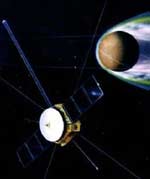
Image credit: JAXA
The Japan Aerospace Exploration Agency (JAXA) has reportedly given up their efforts to have their Mars-bound spacecraft Nozomi reach the Red Planet. A solar flare in 2002 damaged the spacecraft’s electronics and prevented its thrusters from working properly. Engineers were working up until the last minute, but in the end they weren’t able to get the equipment working again. Nozomi will now follow a wide orbit around Mars and then slingshot out into space. Spacecraft from NASA and the European Space Agency will arrive at Mars over the next couple of months.
The Canadian Space Agency (CSA) today confirmed that the Japanese satellite Nozomi has been rerouted away from Mars by JAXA, the Japan Aerospace Exploration Agency. Crucial orbit insertion manoeuvers were impossible to achieve because of defective equipment onboard and the mission has been canceled. Nozomi will now follow a harmless large elliptic solar orbit.
Canada was a partner in this international Mars mission with a $ 5 million Canadian-built scientific instrument onboard — the Thermal Plasma Analyser (TPA). The TPA was designed to analyse the Martian atmosphere to better understand its origin and composition. The University of Calgary was leading the TPA research team and Canadian firms COM DEV International (Cambridge, Ont.), Pakwa Engineering (Saskatoon, Sask.), CAL Corp. (Ottawa, Ont.) and CompAS Electronics (Kanata, Ont.) were involved in the design and building of the instrument.
“This is not a total loss for the Canadian Space Program”, said Alain Berinstain, CSA’s acting Director of Planetary Exploration and Space Astronomy. TPA has positioned Canada as a preferred supplier of state-of-the-art science and technology. It has opened doors to current and future collaborations with Japan and with other countries involved in the exploration of the solar system. Our thoughts are with our colleagues and friends from Japan and we look forward to working with them again in the future.”
In April 2002, on its way to Mars, NOZOMI had experienced a very strong solar energetic proton event associated with a strong solar flare. This caused a short circuit in one of the subsystems and a loss of telemetry signal, which made the Mars orbit insertion impossible.
Original Source: Canadian Space Agency News Release
